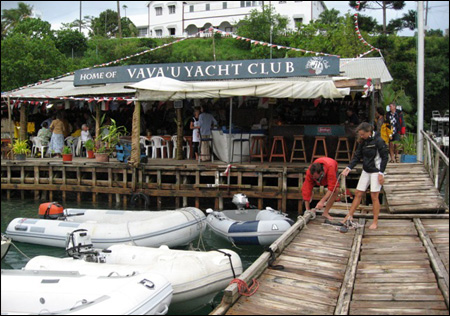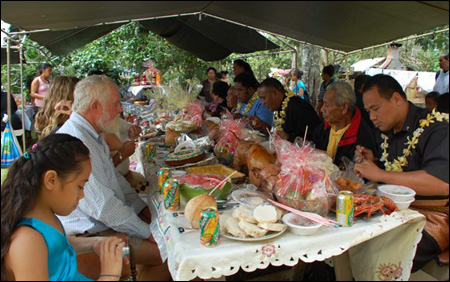Lin Pardey interviews 11 cruising couples fresh from their first major crossing – and finds out what they worried about and what they learned. We are publishing this chapter from Lin’s book “Capable Cruiser” in 2 parts. Part 1 describes worries about bad weather and gear failures. Here, in part 2, Lin Pardey writes about other common worries as well as suggestions for those preparing to set sail.
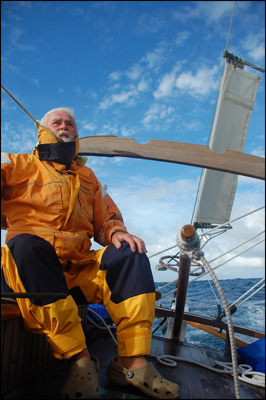 |
Predeparture worries (cont.)
Handling medical issues
• Jack and Marcia Spiess had owned their 44-foot cutter Tracen J for four years before they set sail. They had been cruising off and on since 1988, but this was their first foray across oceans.
“Handling medical issues, heart attack, fractures, and major injuries. That is what concerned me,” said Marcia. But Marcia and her crew, like all of those with whom we spoke, had not had any serious medical troubles.
None had heard of any other voyagers mentioning problems other than two cases of tropical infections caused by cuts that were not treated properly.
• Marilyn Middleton, who cruises with her husband, Glen, and son, Jaryd, on Tin Soldier, a 50-foot steel boat, said health problems at sea had been her worry, too.
Tin Soldier’s medical supplies were rarely used until they reached Neiafu in the Vava’u Islands of Tonga, where Glen decided to join friends on a racing boat for one of the Friday night races organized by a local restaurant owner.
During the race, the boat gybed and the traveler block, which runs on a track across the middle of the cockpit, hit Glen, throwing him against a winch. A broken nose, blackened eyes, and several stitches were much in evidence as we all discussed how much safer ocean voyaging seems to be than living on shore or racing under sail.
Seasickness
• Linda Levy, with her partner Michael Gilbert, left from Florida on board B’Sheret, a 37-foot Najad sloop they bought at the Annapolis Boat Show. Linda listed seasickness right after nasty weather and pirates as a worry that was now relegated to a more comfortable place in her mind. “I was lucky,” Linda said. “I heard all the horror stories but I never got further than anxiety nausea.”
• Interestingly, when I asked others about seasickness, about 60 percent of the interviewees had found they either felt fine or suffered only for a few hours during the first day or two of a passage. The other 40 percent (me included) had found ways to control or cope with seasickness.
Although we met several people in Apia and Tonga who were planning to end their cruises sooner than planned, not one of them said it was because of seasickness.
Running out of food
 |
| Market scene in Western Samoa |
• The crew of both Tracen J and Argonaut listed “running out of food” as something they worried about before they set off.
• But when I look over the answers to the next question we asked, “What did you put on board that was not used?” I realize that this was an almost universal concern. Many lists included comments about carrying too much basic food.
Marcia Spiess stated, “I overprovisioned. All of it took up too much needed space and we ended up giving much of it away. We found that basics, such as flour, rice, etc., were usually available, even in the smallest island shops. Same with meats, fruits, and vegetables. Maybe they were not what we were used to, but it was fun to enjoy the local items.”
• On the other hand, two couples wished they had carried more “comfort foods”—things that would be easy to grab for a snack, specialty items to make real at-home-feeling meals, favorite cookies or dried fruits for nibbling on night watches. These definitely are hard to find or very expensive once you sail far from home.
• Linda Levy from B’Sheret said, “Yes, we overprovisioned, but even without a freezer we were able to eat quick meals from a can and have hot soup all the way to New Zealand. That made me happy when the seas were not happy and all I had to do was open a can, throw it in a pot, heat and eat.”
Most favored gear on board
- Eight out of 10 couples listed their windvane self-steering as the “most favored gear on board.”
- The other two listed their autopilots.
- Six listed their watermaker.
When there was any discussion between husband and wife as to whether the self-steering gear or the watermaker was most important, the answer seemed to split clearly along gender lines, with women strongly in favor of the watermaker.
Best memory
The most enjoyable part of each interview was asking, “What is your very best memory so far?” The answers proved to us that even though there are a lot more folks out here than when we set off 42 years ago, cruising is still a grand adventure.
• Tom Collins and Colleen Wilson, who sailed on 8-ton Mokisha, a handsome 1980s-style S&S 38 built by Catalina Yachts (see fig. 18.1), said, “Nothing compared with the awe of being out at sea, far from land, on a starry night.”
• Linda and Steve on Linda repeated this sentiment, adding, “Catching mahimahi! And we loved Penrhyn Island. It was just about a hundred miles off the normal route, yet we were the only cruisers there and we were shown a wonderful time by the island folks.”
• The Middleton family spoke of spending time at one of the isolated atolls of the Tuamotus and staying with a Polynesian family for a week “There were only two families on the atoll, yet there was a church. The three of us made the Sunday congregation 30 percent larger than normal.”
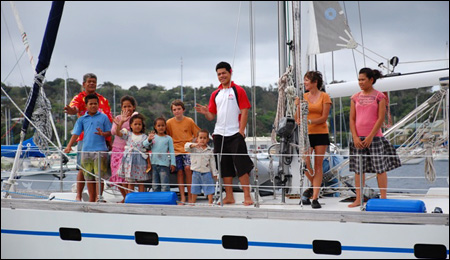 |
| Marilyn and Glenn Middleton with their son Jared wanted to get to know more about the real Tonga. They invited a woman who befriended them at the market place to come out for a Sunday sail. Big Mary arrived with 8 children plus husband. (Marilyn and Jared are wearing the orange T shirts in this photo). This was the beginning of an amazing friendship. |
• “The Pacific Arts Festival,” stated Jack and Marcia Spiess, “It was in American Samoa—only happens once every four years and 27 island nations sent their dancers and singers for 10 days of performances.”
• Several others said, “Beautiful anchorages,” mentioning places as diverse as Hiva Oa in the Marquesas, Niuatoputapu in Tonga, and the eastern side of Bora Bora. “Suwarrow Atoll,” said Michael Gilbert. “It was described as magical by everyone we’ve spoken with and we all believe that the most magic was due to the Cooks Island caretaker and his family who live there.”
The boats they chose to cruise
The boats in which these 10 interviewees chose to cruise ranged from 28 feet in length to 50 feet on deck. All but two had been bought secondhand; two were more than 30 years old. The purchase prices listed ranged from $35,000 to $400,000.
But in spite of their divergent boat choices and budgets, these folks all had one financial reality in common: The cost to upgrade and outfit the boat once they decided to go cruising ran an additional 25 to 35 percent of the purchase price of the boat.
Other advice for those waiting to set sail
What other advice did these cruisers add to their questionnaires for those dreaming of setting off across oceans? Here’s the list:
- Do it sooner rather than later.
- Quit talking and get out here!
- Know your boat, test your gear.
- Buy the best dinghy you can afford.
- Have confidence in your boat.
- Don’t overload your boat or you will feel cramped and uncomfortable.
- Weather will become your life; study and learn about it.
- Once you have prepared thoroughly, relax and enjoy it all.
- Keep a realistic perspective on being out here—far from family, far from easily available materials, equipment, and skilled labor.
- Be mentally prepared for being at sea a long time. “It was better than I thought it would be,” said one cruiser.
- Slow down!
- Learn a few words of the local language. Even saying hello, thank you, and good-bye can open new worlds to you.
- Be wary of the herd mentality. Remember that it’s your dream, your itinerary, and ultimately your decision.
- Get away from other yachties so you experience the local culture.
The last two suggestions are possibly the hardest ones to put into practice.As our three-week stay at the marina in Apia showed us once again, the cruisers you meet “out there” can be a fascinating group of people. Someone will always be coming up with an activity to add to the day’s entertainment—be it a potluck, a diving expedition, a night on the town, or an evening of sharing stories and singing shanties or old favorites.
Over the years, Larry and I have often written, “Go small, go simple, but go now!”To that, we both would like to add: “Do anything necessary to split your shore time 50/50 between getting to know local people and enjoying the company of other cruisers.” No matter how fine your voyaging turns out to be, if you don’t occasionally break away from your newfound cruising friends, you could look back later and find that there was one thing you didn’t worry about that did actually happen. You could come to realize that the only Polynesian people with whom you had contact were customs and immigration officials and vendors at the local marketplace.
|
About Lin and Larry Pardey
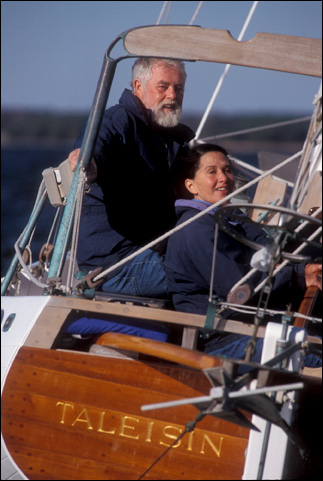 Lin and Larry have voyaged more than 200,000 miles together on self-built engine-free wooden boats. Their voyages have taken them around the world, both east-about and west-about, including counter-to-the-prevailing-wind passages south of the great southern capes.
Lin and Larry have voyaged more than 200,000 miles together on self-built engine-free wooden boats. Their voyages have taken them around the world, both east-about and west-about, including counter-to-the-prevailing-wind passages south of the great southern capes.
Their 11 books and four DVDs include narratives as well as highly useful information on voyaging, storm tactics, boatbuilding, and seamanship.
The Pardey’s have been credited with launching thousands of dreams by inspiring and empowering generations of sailors. Together and separately they have been honored with many awards for their contributions to cruising and sailing. Most recently, in 2010 the Pardey’s were awarded The Cruising Club of America’s prestigious Far Horizons Award.
Currently they have just returned from exploring the waters of New Zealands Hauraki Gulf and will be flying to the US to present seminars and introduce Lin’s newest book – Bull Canyon, A Boatbuilder, a writer and other Wildlife. Monthly newsletters and cruising tips can be found at www.landlpardey.com.
Capable Cruiser
This revised and expanded third edition of The Capable Cruiser includes 10 completely new chapters with such advice as: sixteen ways to encourage your lover (partner) to share your dream; strategies for turning sudden engine failure into a minor incident; choosing safety equipment; repairing rigging at sea. All of the original chapters have been updated to ensure that the information will be helpful for everyone who dreams of cruising—whether now or soon.
The Capable Cruiser is a logical extension of the Pardeys’ Self Sufficient Sailor, with more emphasis on seamanship underway, including careful analysis of extreme anchoring situations and solutions for mitigating them. Underlying each and every chapter is the warmth and encouragement that spurred Herb McCormick, former editor of Cruising World magazine, to label Lin and Larry Pardey “the enablers.”
Read also on this website
- First-time voyagers — What did they worry about that never happened? (Part 1), by Lin Pardey
- Join Lin and Larry Pardey at US West coast seminars as they introduce new book
- Seasickness (Admiral’s Angle column #18): The most asked-about issue of cruising! What are the realities and how can you combat it?
More information (external links)
- Capable Cruiser is available at Lin’s website: www.landlpardey.com and amazon.com
